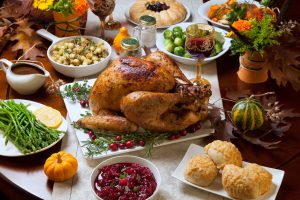Get an early start on planning holiday meals
November 2, 2021
Even if you don’t know what meal you’ll be preparing, compiling a list of spices and pantry staples will help you avoid purchasing the same item twice.
Thanksgiving and Christmas are each only weeks away.
What will these holiday gatherings look like for you and your family this year? You may be planning a large in-person event, more intimate meals for a small group, or going virtual again this year.
Regardless of the venue, or the size of the event, it’s never too early to start the holiday meal preparation.
Starting now allows you to shop more efficiently and be more organized.
Planning is one of the key points. If left to the last minute, meal planning can be a challenge no matter if you’re having a dinner for one or 10. Planning the menu in advance allows you the opportunity to be sure all the favorite dishes are included and spend smarter.
Ways to Start Preparing
Over the next few weeks, begin pulling out your favorite recipes and organizing them by breakfast, entrees, sides, and dessert. Decide which of these you’d like to include with your holiday meals or events. Then check your cupboards to see what you have on hand. We all have certain spices that are family favorites.
Take an inventory of these items and make a note of those which are running low. Don’t forget oils and non-stick sprays. Even if you don’t know what meal you’ll be preparing, compiling a list of these staples will help you avoid purchasing the same item twice.
Your list will save money and remind you to use items on hand first, utilizing them before they expire.
It can also be time to check on utensils and equipment. Have you ever reached for a cookie sheet only to find it is warped? Or you broke the baking dish that was “just perfect” for that special dish. Now is the perfect time to purchase any needed replacement pots, pans, baking sheets, or muffin cups.
Don’t forget other baking, cooking, and serving supplies, such as parchment paper, aluminum foil, cutlery, and table linens (cloth or disposable). These are things you can buy far ahead of time. Cooking for a large group or preparing special foods can have a large price tag. Consider which stores offer the best value for the items in your recipes.
The best buy on spices and for canned goods might be two different stores. By planning this far ahead you can plan to purchase a few of the items each week or every couple of weeks and spread the cost over time. Start with staple items that will keep.
Higher prices, low supplies
Consumers can expect higher prices and fewer options for whole turkeys leading into this Thanksgiving, according to a Texas A&M AgriLife Extension Service expert.

Agriculture experts say Thanksgiving turkeys will cost more this year and be in shorter supply in grocery stores. Some experts suggest supporting regional food providers for more locally-sourced ingredients. It promotes a safer food supply.
The national wholesale average for whole hens is $1.35 per pound, compared to $1.14 per pound this time last year, Anderson said. The five-year average per-pound price is $1.06 for those turkeys.
Shopping local
An alternative to large grocery stores and chain retailers, is to shop local markets and suppliers.
When the Thanksgiving table is set this year, check if something is missing. It may be the care that local farmers, ranchers, bakers and cooks put into their work.
For four years, Illinois Extension Horticulture Educator Kelly Allsup has challenged herself to buy mostly fresh, local ingredients for her family’s meal.
“Buying local foods has become a new Thanksgiving tradition,” Allsup says. “In past years, we have feasted on sweet potatoes, brussels sprouts, carrots, cheese, honey, eggs, and herbs as well as breads and desserts from local bakeries.”
Supporting regional food providers is good for you and your community. It encourages economic growth, benefits the environment and promotes a safer food supply.
Locally grown foods also have more nutrients since they have a shorter time between being harvested and reaching the consumer. Produce grown locally travels an average of 56 miles to market while conventionally grown food travels 1,494 miles, according to a 2003 Iowa State University study.
Allsup encourages people to consider a few local options when shopping for Thanksgiving.
Finding locally grown fresh produce can be difficult in Illinois in November. Some towns have pop-up markets for Thanksgiving and roadside stands may be an option. If you’ve developed a relationship with a farmer at a market, consider contacting them in advance about an order.
It’s likely too late to track down a locally-sourced turkey or ham this year, but next summer ask around at your local farmers market about ordering a locally raised bird in advance.
Honey can be swapped for sugar in many recipes. Honey made by local bees has minerals, vitamins and is a natural energy booster and can be found at markets and natural food stores.
Shoppers may also unintentionally end up with local foods on the table. Whether buying gourds for decorations, canned pumpkin or a premade pie, the source squash is likely from Illinois. About 90 percent to 95 percent of the processed pumpkins in the U.S. are grown in Illinois.
(SOURCES: NC State University, University of Illinois and Texas A&M University extension services)






